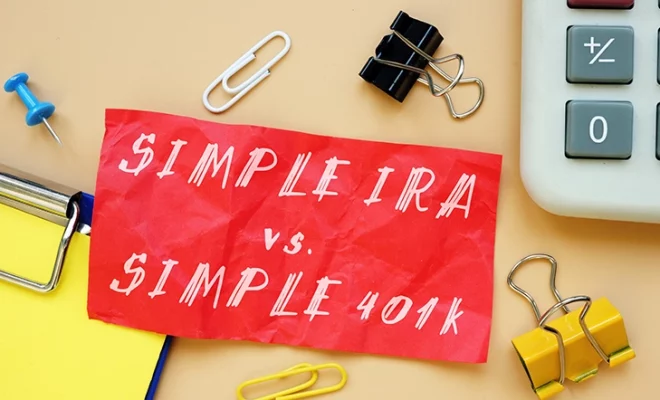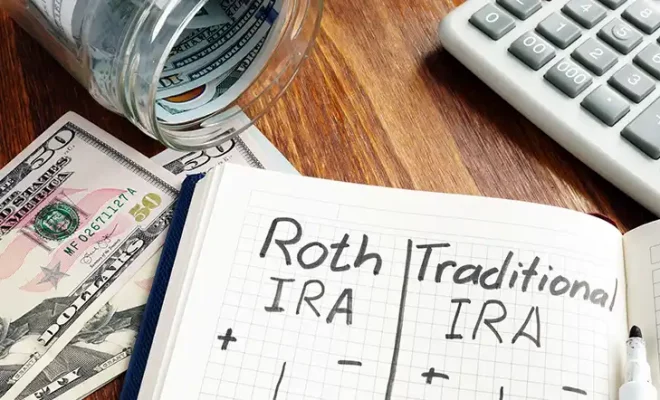The Pros And Cons Of A SIMPLE IRA Versus A 401(k) Plan

While both SIMPLE IRA and 401(k) plans serve the common goal of providing individuals with an opportunity to save for retirement, they differ in certain aspects that can significantly impact employers and employees. The SIMPLE IRA allows small businesses to offer retirement benefits to their employees without imposing excessive administrative burdens. With lower contribution limits and fewer regulatory requirements, the SIMPLE IRA can be an attractive option for small organizations seeking to provide retirement benefits while maintaining ease of implementation. In contrast, the 401(k) plan presents advantages such as higher contribution limits and reduced taxes, enabling employees to save more aggressively for retirement. Consider consulting with a professional financial advisor who can explain the pros and cons of both the plans so you can make an informed decision based on your unique financial needs and goals.
This article explores the pros and cons of both retirement plans and provides a comparison to help you choose the best option for your retirement.
Table of Contents
What is a SIMPLE IRA?
A SIMPLE IRA, or Savings Incentive Match Plan for Employees Individual Retirement Account, serves small businesses having 100 or fewer employees. This plan facilitates tax-deferred contributions, allowing employers and employees to allocate a portion of their pre-tax income toward their individual retirement accounts. Consequently, investors are not required to pay taxes on these contributions until they decide to withdraw the funds in retirement. However, you may have to pay tax on any amount withdrawn before reaching 59.5 years of age. Do note that withdrawals from the SIMPLE IRA are only permitted after a minimum enrollment period of two years.
In addition, the contributions made to a SIMPLE IRA are subject to a maximum contribution limit established by the Internal Revenue Service or IRS. As of 2023, employees can contribute up to $15,500, with an additional catch-up contribution of $3,500 for employees aged 50 or older.
Employer contributions to SIMPLE IRAs are typically determined by the employer and come in two distinct forms: matching and non-elective contributions. Under the matching contribution approach, the employer matches a portion of the eligible employee’s contribution, up to 3% of their compensation. On the other hand, the non-elective formula entails the employer contributing to the employee’s SIMPLE IRA, regardless of whether the employee chooses to contribute or not.
The non-elective contribution is 2% of the employee’s compensation, capped at $330,000 for 2023. This contribution may be subject to adjustments based on the cost of living in subsequent years. Even if an eligible employee opts not to make personal contributions, the employer is still obligated to contribute to their SIMPLE IRA account.
Also see: Is Your 401(k) Losing Money? Here’s What You Can Do
What is the eligibility criteria to contribute to a SIMPLE IRA?
The eligibility for SIMPLE IRA is determined based on employees’ income from any two previous years and their expected income in the current year. To be eligible, employees must have earned a minimum of $5,000 in any two previous years, and their expected income for the current year must also be at least $5,000. Additionally, employers must meet specific eligibility requirements and should not have another retirement plan.
What are the pros of enrolling in a SIMPLE IRA?
The pros of enrolling in a SIMPLE IRA are as follows:
1. Lower administrative costs and simpler setup
Compared to other retirement plans like the 401(k), SIMPLE IRA has the advantage of lower administrative costs and a simpler setup process. This makes it more accessible for small businesses, as they can provide retirement benefits without needing access to extensive administrative resources.
2. No annual reporting requirement
Unlike other retirement plans, the SIMPLE IRA does not necessitate the employer to file an annual report with the IRS. This reduces administrative burden and simplifies the ongoing management of the plan.
3. The employee can choose their investments
With a SIMPLEIRA, employees can control their individual accounts and choose their investment options. This allows investors to align their retirement savings strategy with their investment preferences.
What are the cons of enrolling in a SIMPLE IRA?
1. Lower contribution limits
One of the drawbacks of the SIMPLE IRA is that the contribution limits are lower compared to the 401(k). This limitation may restrict individuals with higher incomes or those aiming to maximize their retirement savings from fully utilizing the plan’s potential.
2. No loan provision
Unlike certain retirement plans, such as the 401(k), the SIMPLE IRA does not permit individuals to take loans from their accounts. This lack of accessibility to retirement savings in emergencies or financial hardships could be a disadvantage for some individuals.
What is a 401(k) retirement account?
A 401(k) is an employer-sponsored retirement savings plan that allows employees to save a portion of their pre-tax income into an investment account, facilitating tax-free growth until retirement.
This plan allows employees to choose the percentage of their paycheck they wish to contribute during each pay period. Such flexibility allows for larger contributions, helping them accumulate a substantial retirement fund over time. Moreover, these contributions help reduce their taxable income by deducting the specified contribution amount at the time of enrollment.
In addition to employee contributions, many employers also contribute to their employees’ 401(k) accounts. However, the extent of employer contributions is at the employer’s discretion. Some generous employers even offer to match as much as 100% of the employee’s contributions (up to a specified percentage of the employee’s total compensation).
While employees can allocate their entire salary to a 401(k) plan, there are specific eligibility requirements and contribution limits to consider. In 2023, the maximum amount an employee can contribute to a 401(k) plan is $22,500. For individuals aged 50 or older, an additional catch-up contribution of $7,500 is permitted, increasing the employee contribution limit to $30,000. Furthermore, the combined limit for employee and employer contributions is set at $66,000.
These contribution limits serve as important guidelines to ensure that individuals are mindful of their retirement savings strategy and remain within the framework of the 401(k) plan. While the plan allows for substantial contributions, it also helps promote a balanced approach to saving by imposing limits that prevent excessive allocations.
What is the eligibility criteria to contribute to a 401(k)?
401(k) eligibility criteria can vary depending on the employer. Still, typically employees must have completed 12 months of service with the company and be at least 21 years old to enroll in the plan. Certain employers may also impose additional age requirements or restrictions, further influencing eligibility.
What are the pros of enrolling in a 401(k) plan?
The advantages of enrolling in a 401(k) plan are as follows:
1. Higher contribution limits
One of the major advantages of a 401(k) plan is its higher contribution limits compared to other retirement plans like the SIMPLE IRA. This enables people to save a larger portion of their income for retirement, potentially accelerating the growth of their retirement savings over time.
2. Employer match benefits
401(k) plans allow employers to make matching contributions to their employees’ accounts. The employer can match a percentage of the employee’s contributions, which can effectively boost overall retirement savings. In some cases, employers may even offer a 100% match, further enhancing the value of the plan.
3. Tax-deferred growth
Another significant benefit of a 401(k) plan is the tax-deferred growth it offers. The contributions to the account grow on a tax-deferred basis, allowing the funds to compound and potentially generate higher returns over the long term. Taxes are only paid when withdrawals are made during retirement.
Also see: Can I Roll Over My 401(k) to a Roth IRA While Still Employed?
What are the cons of enrolling in a 401(k) plan?
The cons of enrolling in a 401(k) plan are:
1. Higher administrative costs
One of the drawbacks of a 401(k) plan is the relatively higher administrative costs compared to other retirement plans. These costs, including recordkeeping, compliance, and investment management expenses, can impact the overall investment returns and potentially reduce the net gains from the plan.
2. Complex setup process
Setting up a 401(k) plan can be a complex and time-consuming process, requiring employers to navigate various legal and administrative requirements. This complexity may deter some smaller businesses from offering a 401(k) plan.
3. Limited investment options
While 401(k) plans provide investment opportunities, they often offer a limited selection of investment options. This lack of diversity can restrict individuals from fully diversifying their investment portfolio within the plan, potentially limiting their potential returns or deploying risk management strategies.
The key differences between a 401(k) and a SIMPLE IRA summarized
|
|
SIMPLE IRA | 401(k) |
|
Eligibility |
Available to companies with 100 or fewer employees | Available to companies of any size |
| Contribution Limits | $15,500 for employees under 50; $19,000 for employees 50 and older |
$22,500 for employees under 50; $30,000 for employees 50 and older |
|
Employer contribution |
The employer is mandated to match employee contributions up to 3% or make a 2% non-elective contribution | Optional, but may match employee contributions even up to 100%; up to a certain percentage of salary |
|
Vesting |
Immediate vesting | Vesting schedule determined by the employer |
| Withdrawals | Can withdraw funds penalty-free after two years |
10% penalty for early withdrawals before age 59 1/2, with some exceptions |
| Administrative Complexity | Simple and easy to administer |
More complex and may require a third-party administrator |
| Costs | Lower costs for employers and employees |
Higher costs for employers and employees |
401(k) vs. SIMPLE IRA: Which is the better option for small businesses?
When it comes to retirement savings options for small businesses, the choice between a 401(k) and a SIMPLE IRA can be a pivotal decision. Both plans offer distinct advantages that can significantly impact the financial well-being of both employers and employees.
The 401(k) plan stands as a well-established and widely recognized option, boasting higher contribution limits and potential employer-matching contributions. On the other hand, the SIMPLE IRA offers simplicity, lower administrative costs, and accessibility for businesses with fewer employees. Evaluating the specific needs and goals of a small business, as well as considering factors such as administrative responsibilities, contribution limits, and investment options, becomes crucial in determining which plan aligns best with the company’s vision and the employees’ long-term financial objectives.
To conclude
Choosing the right retirement savings plan for your needs can help you secure funds for an easy lifestyle post retirement. While both a SIMPLE IRA and a 401(1k) account allow you to invest pre-tax dollars, some features distinguish the two: The SIMPLE IRA is a good option for employees and organizations seeking lower administrative costs and uncomplicated setup processes. On the other hand, those looking for higher contribution limits and the ability to take loans in case of emergencies may consider a 401(k) account. Understand the pros and cons between a 401(k) and a SIMPLE IRA and evaluate them against your current financial situation and goals to make an informed decision about your financial future.
If you’re unsure of which retirement plan to choose between a 401(k) and a SIMPLE IRA, consider using the free advisor match tool to match with experienced financial advisors who can help explain the pros and cons of both plans. Answer a few questions based on your financial needs, and the match tool will help connect you with 1-3 financial advisors that may be suited to help you.


















